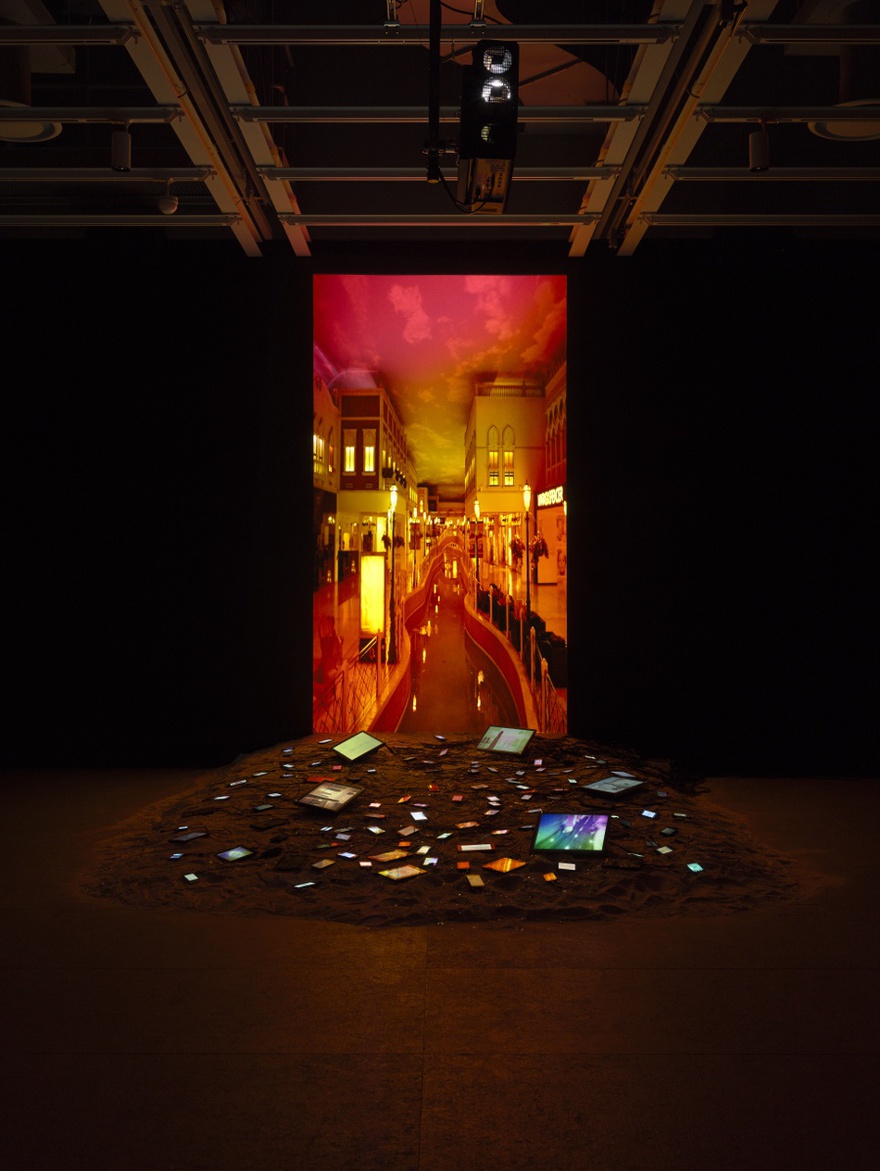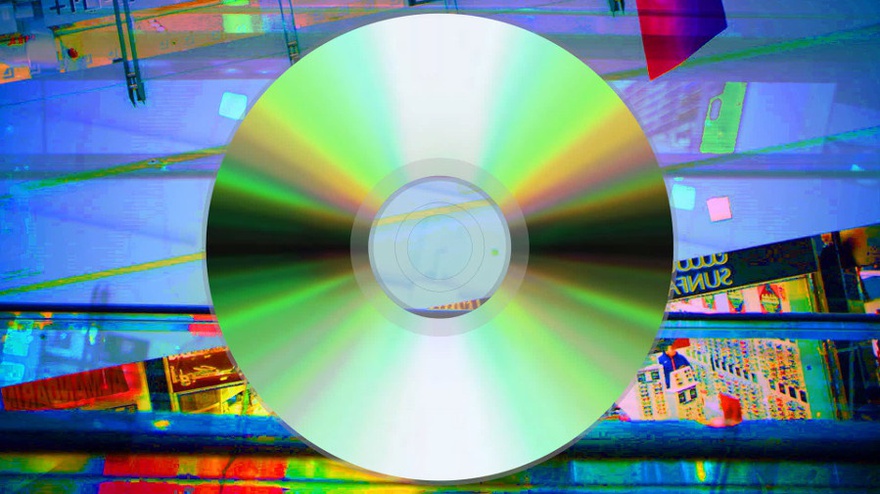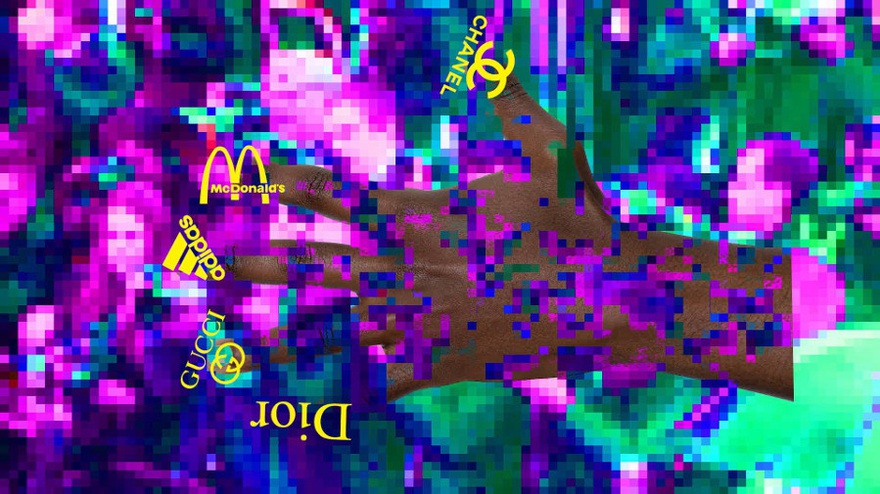Reviews
Black Friday
Sophia Al-Maria at the Whitney Museum of American Art
Black Friday, Sophia Al-Maria's first solo exhibition in the United States, is an installation presented within a single, darkened space on the ground floor of the Whitney Museum of American Art. The first component comprises of a large screen – tall, narrow, statuesque – on which a roughly seventeen-minute film, also named Black Friday, is projected. The film was shot by drone in two locations in Qatar: the Villagio Mall, where a fire in 2012 killed 18 people (as the artist notes, smoke marks are still visible on the blue-sky painted ceilings that feature in the film), and Al Hazm, a next-level (and not-yet-opened) luxury shopping destination that supposedly boasts 400-year-old olive trees imported from Spain as part of its décor. Shown on a loop, the film's 'end' and 'beginning' are both marked by a close-up shot of two escalators, one going up, another coming down: a scene that recalls one of the book covers for JG Ballard's 2006 dystopian murder mystery, Kingdom Come, from which – as the artist tells me – the exhibition takes inspiration. (The book, like Al-Maria's film, is about a death in a mall.)
At the start, we see the escalators glide, their soft machinic hum accompanied by an ambient melody that increases in volume until the song is broken by the sound of an electronic glitch. The scene cuts to an acid-toned (pink, orange, and yellow) close-up profile of a baby; the sound of breathing becoming the only audible sound. Then, a similarly toned mall interior comes into view, complete with security cameras attached to a pole like fruit on a tree. An ominous voiceover, performed by actor Sam Neill, offers a sermonic introduction to the film's subject: 'Not the dark satanic mills of the 19th century, but the bright fluorescent malls of the 21st' – each a 'frameless frame of forever' where 'the glamorous heart of evil is born'.
Black Friday's screen rests on The Litany, a mound of sand littered with glass shards and smart devices of various sizes joined together by USB cables; what Al-Maria describes as the 'flickering embers' to the film's 'burning flame'. Each screen presents a series of flashing images that play on repeat – an unsettling melange of edited footage, some composed of rushes taken from Black Friday itself, all doctored to express the sheer techno-dystopian clusterfuck this installation reflects. On one phone, a man penetrates a woman from behind on repeat, masks covering each face; while on a tablet nearby, a series of escalators are cut and pasted to cross over one another as various currency symbols, from $ to £, flash in yellow. Accompanying these visuals is an unforgiving soundtrack that offers a nightmarish chorus to Black Friday's film narration; it was composed by sound designer Nicolas Becker, who responded to thematic pointers from Al-Maria ('apocalyptic sky trumpets!', 'geological screaming!' included) in order to create a non-ambient techno-dystopian version of Muzak.
The Litany lives up to its name – as a tedious repetition, or a call-and-answer form of ritual prayer – and to its conception as 'a coded history of consumption, conflict, and desire'. On one device, footage from a protest is shown in black and white, over which the text 'HANDS UP, SALE ON' hovers: a haunting reminder of the 2014 police shooting of Michael Brown, the protest phrase that became a rallying cry throughout the U.S. as a result ('hands up, don't shoot'), and the amnesiac culture that enables such violence to continue unabated. Like an afterimage of Nam June Paik's 1974 TV Garden, predicated as it was on the dawn of connectivity and the optimism that came with its promise, this is an expression of capitalism's networked mantras exposed, in which the façade of the global, consumerist cathedral is stripped bare and its ulterior tendencies brought to the surface. The result is an articulation of what Al-Maria once described as the 'interlocking conspiracy' that mobile phones planned for us all along – a conspiracy that, much like the mall, indoctrinates everyone into a 'new form and language, escorting us onto its inviting network and locking the exit behind us.'[1]
The effects of this conspiracy are far-reaching, as this exhibition's title suggests. 'Black Friday' is a phrase that is as mimetic and global a construction as the shopping mall itself. In the United States, for instance, it can refer to the day after Thanksgiving, in which major discounts are offered at stores across the country; conversely, it can also refer to the day in 1869 when the U.S. gold market crashed. In Iran, Black Friday refers to a protest in 1978 that was violently suppressed, and which became a catalyst for the Iranian Revolution. More recently, the day following the United Kingdom's Brexit vote – a Friday – has been referred to as a black one, given the £120 billion that was wiped off the value of blue-chip London-listed shares that morning, and the $2 trillion that disappeared from global markets that day. The list of Black Fridays goes on, none of them celebratory, bar the crucifixion of Christ (depending on how you look at it). All of which brings us back to the day after Thanksgiving: itself a holiday that, in reality, commemorates the subjugation of Native Americans by European colonialists in the name of 'freedom'.
It is through this common phrase, then, together with the common space of the mall, that Al-Maria creates the scene of a universal crime. The mall of Black Friday's conjuring is the Metro-Centre of JG Ballard's Kingdom Come made virtually real. It is presented here – to borrow Ballard's depiction – as a church that preaches a violent and viral reverence for the future, and which in turn subtly infantilize its visitors (as Ballard observed) through promises of 'an experience more meaningful than self-knowledge or eternal life'. For Al-Maria, the shopping mall is an apparatus of disaster capitalism: a term Naomi Klein used to describe the use of a 'shock doctrine' in various US-led invasions, particularly the second Iraq War, that is predicated on 'civilizing' territories by installing free-market capitalist 'democracies' through violent means. In Ballard's tale, it is when a murder takes place in Ballard's mall that the site forces its visitors to grow-up (or in other words, conform), thanks to the installation of security at all entrances and exits as a result of the violence.
But while Al-Maria explores the disaster of capitalism – and its acceleration – throughout the post-war Gulf region and beyond, her study is not limited by time. We could further back in history to chart the way trade and consumption have been deployed as a means to colonize, after all; take the history of Britain's East India Company and the Opium Wars, for example, or the end of World War I, which is the moment for Al-Maria that 'the disaster of late capitalism' came to the Gulf (when the Saudi oil pumps started working). Likewise, we could cast our gaze on the immediate present at the location of Al-Maria's exhibition itself: New York, the city where the Guggenheim, New York University, and Tribeca Film Festival are all located: three institutions that have been involved in strategic partnerships in the Gulf. (The Doha Tribeca Film Festival ran from 2009 to 2012, the New York University's Abu Dhabi campus was inaugurated in 2010, and the Guggenheim Abu Dhabi is set to open in 2017.) And while Al-Maria's critique of mall culture is very much rooted in the rise of consumerism and technological progress in the Gulf, she does not lose sight of where this culture came from, and how it has since developed outside the source.
That Black Friday is being shown at the Whitney Museum – itself a public and privately funded, starchitect designed megalith not unlike the new museums of the Gulf – is telling. The exhibition is composed to mimic a shrine within a museum that adopts the aura of a church, in which an ideology of art that is as global as 'shopping' is performed. Suddenly, what appears to be a commentary on the mall as an apparatus of security becomes something even more vicious: a critique aimed at consumerism at its highest, and most formal, level – art and high culture, and the bloodied histories associated with the circulation and imposition of both. Here, the ourouboros of Black Friday's film loop is transformed; no longer the representation of an unstoppable cycle we cannot escape, but a moment in which capitalism's mouth – or mouthpiece – reaches its tail and bites it.
Black Friday is on view at the Whitney Museum of American Art from 26 July to 31 October 2016. For more information, see: http://whitney.org/Exhibitions/SophiaAlMaria
[1] Sophia Al-Maria, The Gaze of the Sci-Fi Wahabi, http://scifiwahabi.blogspot.co.uk/

















